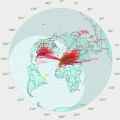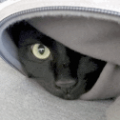benson
About
- Username
- benson
- Joined
- Visits
- 7,796
- Last Active
- Roles
- Member
- Points
- 12
-
Windows KiwiClient & Co
Hi Paul,
I am assuming that you have Python installed correctly and already unzipped the kiwiclient package.Depending on how far you got with trying to run kiwirecorder and using Python on your windows machine you can try the following steps.
1. With explorer go to the directory where you unzipped the kiwiclient repository into.
2. Check Python is properly installed by opening CMD and typing python or perhaps python3 in your installation. To exit python type in exit()
3. For the remote kiwi(s) you want to use, have the ip adresses and port numbers ready.
4. As example here Shannon Volmet parallel transmission is used on 5505 and 8957 and a kiwi receiver in Finland. Provided the remote Kiwi has 2 slots available it will record both transmissions which then show up in your above mentioned kiwiclient directory. In the CMD window type:
python kiwirecorder.py -k 30 -s kiwisdr.oh6ai.fi,kiwisdr.oh6ai.fi -p 8073,8073 -f 5505,8957 -m usb -L 200 -H 2700
Stop the recording after a minute with the CTRL + C keys combination.
5. Once you got this working, have a look at kiwirecorder.py --help to see what else you want to add, like limiting the recording time, add squelch parameters, append a station name or adding a directory where you want to save those wav files.
Best regards, Ben
-
Automatic signal classification
An interesting attempt to classify demodulated signals by using audio fingerprinting of known samples is published by Jose Rueda (http://jcrueda.com/?p=916). It is based on a Python program called Dejavue which is meant to recognise songs from just "listening" to a small fragment. A good explanation is in the program description at ( http://willdrevo.com/fingerprinting-and-audio-recognition-with-python ).
This looks like a great idea, but trying this out on live signals from a Kiwi SDR gives rather low accuracy and a lot of false captures (mis-identification). This perhaps is not surprising because of the large amount of QRM and QRN mixed in with the audio signals. In addition filter bandwidth, gain and center frequency chosen for demodulation can make identification more difficult. It may be worth an attempt to use live recordings from the Kiwi as "known samples" to replace the mostly high SNR sample data that Jose extracted from the sigidwiki.com database.
Another route would be to use deep learning based signal classification and train a Convolutional Neural Network (CNN) using a much larger set of sampled data that would covering a wide range of SNR's and other variations. This would involve a lot of work though.
Aside from demodulated data as input the IQ datastream could be used to also classify the modulation type. Using either Tensorflow or Python Keras deep learning networks by Randaller shows some promising results ( https://github.com/randaller/cnn-rtlsdr ).
It is still early days for BB-AI adaptation into the Kiwi project but it seems the AI would be quite capable for this type of classification job.
Probably some folks on this forum have already looked at this and are willing to contribute ideas, code and results.
Anyway I just bring up auto signal classification as one of the many possible further development directions that would be unique.
Best regards, Ben -
sdr.hu is now REALLY closed for non-amateurs
One of those less well known but excellent alternatives is directKiwi created by llinkz.
(https://github.com/llinkz/directKiwi)
The program allows you to select any of the available Kiwi receivers on a map interface GUI and get the streaming audio signal, with a mouse click you can obtain the current SNR estimate as used to be available on Marco's IS0KYB website using his micro -kiwi-waterfall routine and it shows the not so frequently updated SNR measurements from rxfanel page.
I have been using this for quite some time to find the better performing Kiwi's bypassing the obviously manipulated voting method that occurred at sdr.hu
73, Ben
-
sdr.hu is now REALLY closed for non-amateurs
An article in 'Janes Intelligence Review' last year certainly points in that direction. A snippet of that article can be found in the link below. Written by one of Jane's editors it might carry some weight.
link: https://www.janes.com/images/assets/042/83042/Software-defined_radios_point_way_for_simpler_direction_finding.pdf -
sdr.hu is now REALLY closed for non-amateurs
One of those less well known but excellent alternatives is directKiwi created by llinkz.
(https://github.com/llinkz/directKiwi)
The program allows you to select any of the available Kiwi receivers on a map interface GUI and get the streaming audio signal, with a mouse click you can obtain the current SNR estimate as used to be available on Marco's IS0KYB website using his micro -kiwi-waterfall routine and it shows the not so frequently updated SNR measurements from rxfanel page.
I have been using this for quite some time to find the better performing Kiwi's bypassing the obviously manipulated voting method that occurred at sdr.hu
73, Ben








